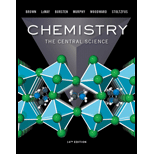
Concept explainers
Carbon monoxide, CO, is isoelectronic to N2.
a. Draw a Lewis structure for CO that satisfies the octet rule.
b. Assume that the diagram in Figure 9.46 Q can be used to describe the MOs Of CO. What is
the predicted bond order for CO? Is this answer in accord with the Lewis structure you drew in
part (a)?
c. Experimentally, it is found that the highest energy electrons in CO reside in a MO Is
that observation consistent With Figure 9.46 Q? If not, What modification needs to be made to
the diagram? How does this modification relate to Figure 9.43Q?
d. Would you expect the MOs of CO to have equal atomic orbital contributions from the C
and O atoms? If not, which atom would have the greater contribution?
Want to see the full answer?
Check out a sample textbook solution
Chapter 9 Solutions
Laboratory Experiments for Chemistry: The Central Science (14th Edition)
- Use the MO model to explain the bonding in BeH2. When constructing the MO energy-level diagram, assume that the Bes 1s electrons are not involved in bond formation.arrow_forwardLight of appropriate wavelength can break chemical bonds. Light having λ < 240 nm can dissociate gaseous O2. It requires light with λ < 819 nm to dissociate gaseous H2O2 to 2 OH. Assume that all of the photon energy is used solely for these dissociations. (a) Calculate the energy required to dissociate (i) O2 and (ii) H2O2. (b) Consider the results of part (a). How well do they correlate with the Lewis structures of O2 and H2O2? Explain your answer.arrow_forwardFClO2 and F3ClO can both gain a fluoride ion to form stable anions. F3ClO and F3ClO2 will both lose a fluoride ion to form stable cations. Draw the Lewis structures and describe the hybrid orbitals used by chlorine in these ions.arrow_forward
- Bond Enthalpy When atoms of the hypothetical element X are placed together, they rapidly undergo reaction to form the X2 molecule: X(g)+X(g)X2(g) a Would you predict that this reaction is exothermic or endothermic? Explain. b Is the bond enthalpy of X2 a positive or a negative quantity? Why? c Suppose H for the reaction is 500 kJ/mol. Estimate the bond enthalpy of the X2 molecule. d Another hypothetical molecular compound, Y2(g), has a bond enthalpy of 750 kJ/mol, and the molecular compound XY(g) has a bond enthalpy of 1500 kJ/mol. Using bond enthalpy information, calculate H for the following reaction. X2(g)+Y2(g)2XY(g) e Given the following information, as well as the information previously presented, predict whether or not the hypothetical ionic compound AX is likely to form. In this compound, A forms the A+ cation, and X forms the X anion. Be sure to justify your answer. Reaction: A(g)+12X2(g)AX(s)The first ionization energy of A(g) is 400 kJ/mol. The electron affinity of X(g) is 525 kJ/mol. The lattice energy of AX(s) is 100 kJ/mol. f If you predicted that no ionic compound would form from the reaction in Part e, what minimum amount of AX(s) lattice energy might lead to compound formation?arrow_forwardDo the Lewis structure of Urea (NH2)2CO 1. lewis structure2. assign the VSEPR model of the central atom3. Value of the corresponding theoretical angle4. classify 3 of the different bonds around the central atom as ionic or covalent5. draw the complete 3-D structure with respect to the central atom (s)6. draw the lewis structure for another mnolecule or species with a different atomic arrangementarrow_forwardFor the following molecules: A. XeO₂F2 (neutron diffraction experiment by Peterson, Willett and Huston.[¹] showed that F-Xe-F bond angle is 180°) B. CIF 3 (1) Draw the valid Lewis structure, identify the (2) molecular group geometry, (3) electron group geometry, (4) polarity of the bonds, (5) over-all polarity, (6) number of lone pairs, and (7) number of bonding pairs.arrow_forward
- 15. For the molecule aluminum trichloride, AC13, the Cl-Al-Cl bond angle is 120°. If the Al-Cl bond length is 206 pm, use trigonometry to find the inter-atomic separation between the two Cl atoms. Assume the molecule is trigonal planar (i.e. flat).? ci ci: A B C D E 178.4pm 356.8pm 103pm 51.5pm None of the above. AI CI: Oniaarrow_forwardThe average bond energy (enthalpy) for a C=C double bond is 614 kJ/molkJ/mol and that of a C−C single bond is 348 kJ/molkJ/mol. If it takes 4.42×10−19 J/molecule to break the C=C double bond. What is the longest wavelength λ of light that will provide photons of sufficient energy to break the π bond and cause the isomerization? Express your answer numerically in nanometers.arrow_forward1a) Create a drawing of the lewis structure of the ion ?3 2+, show your work (show all your work, total electron count, etc). b) How many total nodes are present in a 4d orbital? How many are radial and how many are angular?arrow_forward
- The arrangement of electron groups around the Xe atom in XeF4 is A. tetrahedral. B. trigonal bipyramidal. C. square planar. D. octahedral. E. square pyramidal.arrow_forward7. Draw three valid Lewis structures for HNPH and predict the most likely HNP and NPH bond angles. Explain your reasoning.arrow_forwardWrite out the electron configurations, and the bond-orders for: C2 (2+), C2 and C2 (2-). Which substance will have the longest bond? Are any of these species paramagnetic? Explain.arrow_forward
 Chemistry & Chemical ReactivityChemistryISBN:9781133949640Author:John C. Kotz, Paul M. Treichel, John Townsend, David TreichelPublisher:Cengage Learning
Chemistry & Chemical ReactivityChemistryISBN:9781133949640Author:John C. Kotz, Paul M. Treichel, John Townsend, David TreichelPublisher:Cengage Learning Chemistry & Chemical ReactivityChemistryISBN:9781337399074Author:John C. Kotz, Paul M. Treichel, John Townsend, David TreichelPublisher:Cengage Learning
Chemistry & Chemical ReactivityChemistryISBN:9781337399074Author:John C. Kotz, Paul M. Treichel, John Townsend, David TreichelPublisher:Cengage Learning Chemistry for Engineering StudentsChemistryISBN:9781337398909Author:Lawrence S. Brown, Tom HolmePublisher:Cengage Learning
Chemistry for Engineering StudentsChemistryISBN:9781337398909Author:Lawrence S. Brown, Tom HolmePublisher:Cengage Learning
 ChemistryChemistryISBN:9781305957404Author:Steven S. Zumdahl, Susan A. Zumdahl, Donald J. DeCostePublisher:Cengage Learning
ChemistryChemistryISBN:9781305957404Author:Steven S. Zumdahl, Susan A. Zumdahl, Donald J. DeCostePublisher:Cengage Learning Chemistry: An Atoms First ApproachChemistryISBN:9781305079243Author:Steven S. Zumdahl, Susan A. ZumdahlPublisher:Cengage Learning
Chemistry: An Atoms First ApproachChemistryISBN:9781305079243Author:Steven S. Zumdahl, Susan A. ZumdahlPublisher:Cengage Learning





